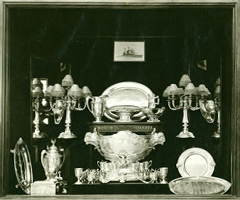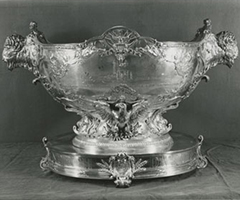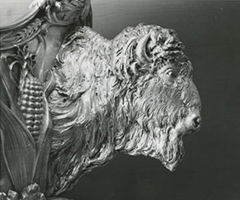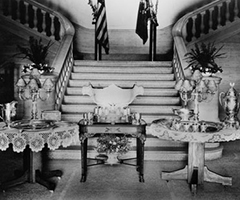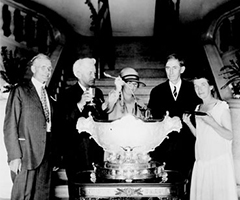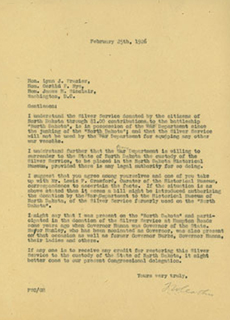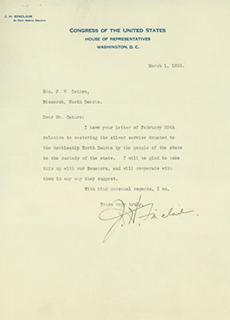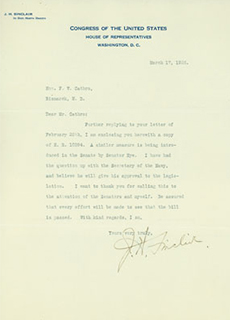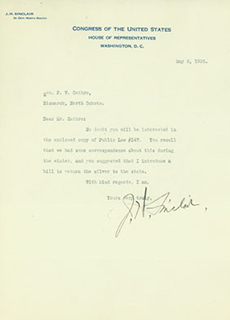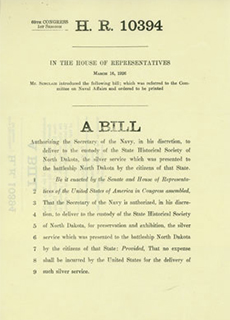Introduction
Did you know that North Dakota floated on the ocean less than 100 years ago? It’s true! Proof can be found at the North Dakota Heritage Center in Bismarck. Of course, that North Dakota was not the state, but it was named in honor of the state of North Dakota. What was the North Dakota?
The USS North Dakota was a huge battleship that belonged to the United States Navy. This enormous ship was 518 feet long (almost the length of two football fields), 85 feet wide, and weighed 20 thousand tons (40 million pounds). Nearly 1,000 sailors lived aboard this “USS,” or “United States Ship.” At the time it was built, the USS North Dakota was the biggest, fastest, and most powerful battleship in the world.
On November 10, 1908, Governor John Burke and about 150 other North Dakotans traveled to Quincy, Massachusetts for the launching of the USS North Dakota. The ship was completed and put into official use on April 11, 1910. This battleship was used for training sailors, carrying troops, and guarding the East Coast of the United States. It never took part in a battle.
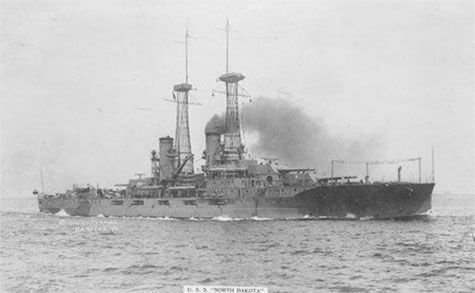 USS North Dakota. SHSND 2002-P-15 Album2-P14b
USS North Dakota. SHSND 2002-P-15 Album2-P14b
The Gift
A tradition, or custom, at the time of the building of the USS North Dakota was for the people of a state to purchase a silver service for a ship named in honor of their state. A silver service is a set of fancy dishes made of silver or coated with silver. The dishes are used for special occasions to serve punch, coffee, or sometimes meals. A silver service often includes a punch bowl; cups; a ladle, or dipper; several platters, or large serving plates; and candelabra (kan-dah-LAH-brah), or fancy candlesticks.
When the U.S. Navy decided to name a ship in honor of North Dakota, Governor John Burke appointed a commission, or committee, to be in charge of purchasing a silver service for the ship. The commission’s job was to decide which pieces would be included, to choose a design, and to order the items.
The commission members got together and decided that the silver service for the USS North Dakota would be made up of 40 pieces. The largest and heaviest piece of the set would be the punch bowl. Gorham Silver Company of New York was hired to make the silver dishes.
A contest was then held to see who could come up with the best design to decorate the silver service. The winner was 24-year-old Hans Klimmek of Fargo. His prize for winning the contest was $50 (about $1,250 in today’s dollars). Mr. Klimmek worked as an engraver for a printing company, so he knew a lot about making designs. An engraver is someone who carves designs into metal, wood, or other materials.
Mr. Klimmek based his designs on scenes and symbols of North Dakota. The large punch bowl had carved bison heads for handles and was decorated with engravings of Indian tipis, a covered wagon, tractors, a city with a rising sun, and images from the official State Seal of North Dakota. The wild prairie rose, North Dakota’s state flower, was engraved onto many of the dishes.
The commission expected that the silver service would cost about $10,000 (about $250,000 in today’s dollars). In order to raise money, fundraising committees were set up in all 53 counties of the state. Each county was to raise a certain amount of money to help pay for the silver service.
When the dishes were all finished, however, they ended up costing $16,000 (about $400,000 in today’s dollars). That was a lot of money for the people of North Dakota to raise, and they were not able to reach their goal by the time the ship was finished in 1910. Because the silver service had not been paid for, it could not be given to the USS North Dakota.
In 1914, the commission again tried to raise money. This time, they asked banks and organizations for help. Several banks around the state, as well as the Elks Club, the Knights of Columbus, and other organizations donated money. This money was added to the funds that had already been collected by the counties, and the goal of $16,000 was reached.
On May 15, 1915, five years after the USS North Dakota went to sea, the ship finally received the gift from its honored state. A group of people from North Dakota, including Governor L.B. Hanna, had traveled to New York City. As the big battleship was docked in New York Harbor, the North Dakotans presented the beautiful 40-piece engraved silver service to U.S. Navy officers on board the USS North Dakota.
The silver service of the USS North Dakota now had its permanent home. Or did it?
The Gift Comes Home
In 1922, the United States signed a treaty with four other large nations of the world. The purpose of this agreement was to help keep world peace. The five countries signing the treaty all promised to reduce the size of their navies.
The U.S. Navy needed to decide which battleships to give up. Because the USS North Dakota had been having a lot of engine trouble, it ended up on the list of U.S. ships headed for destruction.
In 1923, the USS North Dakota was taken out of use. The silver service, which had been a gift from the people of North Dakota, was removed and packed into boxes. It was then placed in storage at a U.S. Navy base in Virginia.
Frederick Cathro, a citizen who had attended the silver service presentation in 1915, had an idea. He thought that the people of North Dakota should get their silver dishes back. He wrote letters to James Sinclair, North Dakota’s US. Representative in Congress, asking if he could help get the silver service back to its home state.
Congressman Sinclair liked Mr. Cathro’s idea. He met with North Dakota’s two U.S. Senators, Gerald Nye and Lynn Frazier. They also agreed that the dishes should be moved to North Dakota.
Congressman Sinclair introduced a bill into Congress, and the bill became law on April 24, 1926. The law stated that the silver service from the USS North Dakota should be the responsibility of the State Historical Society of North Dakota. It would still belong to the U.S. Navy but would be on loan to the people of North Dakota.
In July of 1926, the silver service was taken out of storage and briefly put on display in Grand Forks, Fargo, and several other North Dakota towns. It was then brought to the Liberty Memorial Building on the State Capitol grounds in Bismarck. At that time, this building housed the official state museum. Governor Arthur Sorlie and his wife hosted a reception at which 800 people welcomed the set of silver dishes to its new home.
Between 1915 and 1923, the silver dishes from the USS North Dakota had traveled to England, France, Cuba, Italy, Spain, and all along the East Coast of the United States. These silver pieces, however, were more than just fancy dishes that had been used on a ship. They became significant artifacts.
In this context, an artifact is a human-made object that is an important part of history. Artifacts are objects that were made in the past and teach us about how people lived and what was important to them. Today, they remind us about our history and help us understand our past.
When the North Dakota Heritage Center opened in 1980, the silver service was moved to this new state museum. In 1997, the Navy asked Congress to amend the rules so that the people of North Dakota could now own the silver service. Today, many pieces of this valuable treasure are on display for everyone to enjoy.
Would you like to use your silver service? You may get that chance! Every four years, everyone is invited to the Governor’s Inaugural Ball in the capital city of Bismarck. At this event, punch is served from a silver punchbowl.
The punchbowl has carved bison heads for handles; it is beautifully engraved with symbols of North Dakota; it is the largest piece of a beautiful silver service. This is the same punchbowl that once sailed the high seas aboard the mighty U.S. battleship, the USS North Dakota!
Terms and People
- Artifact:
- A human-made object that is an important part of history
- Burke, John:
- Served as North Dakota’s Governor from 1907 to 1913
- Served as U.S. Secretary of the Treasury from 1913 until 1921
- Served as a justice on the North Dakota Supreme Court from 1929 to 1931 and from 1935 to 1937
- Cathro, Frederick:
- Was a teacher, farmer, and banker at Bottineau
- Served two terms as Deputy Superintendent of Schools from 1889 to 1893
- Took steps to have the silver service from the USS North Dakota brought to North Dakota
- Frazier, Lynn:
- Served as Governor of North Dakota from 1917 to 1921
- Served as U.S. Senator from 1922 to 1941
- Hanna, L.B.:
- Served in North Dakota House of Representatives from 1895 to 1897
- Served in North Dakota State Senate from 1897 to 1901 and 1905 to 1909
- Served in U.S. House of Representatives from 1909 to 1913
- Served as Governor of North Dakota from 1913 to 1917
- Liberty Memorial Building:
- Located on the State Capitol Grounds
- Completed in 1924
- Home of the State Historical Society of North Dakota from 1924 to 1967
- Now houses the State Library
- North Dakota Heritage Center:
- Located on the State Capitol Grounds
- Completed in 1967
- Official State Museum of North Dakota
- Operated by the State Historical Society of North Dakota
- Nye, Gerald:
- Worked as a newspaper publisher
- Served as U.S. Senator from 1925 to 1945
- Silver service:
- A set of fancy dishes made of silver or coated with silver
- Used for special occasions to serve punch, coffee, or sometimes meals
- Often includes a punch bowl; a ladle, or dipper; several platters, or large serving plates; and candelabra, or fancy candlesticks
- Sinclair, James
- Was a teacher, a superintendent of schools, a banker, and a farmer
- Served as the U.S. Representative in Congress from 1919 to 1935
- Sorlie, Arthur
- Served as Governor of North Dakota from 1925 to 1928
- Died in office in 1928
- State Historical Society of North Dakota:
- Collects, preserves, manages, and displays historical artifacts
- Has operated since 1895
- Headquartered in the North Dakota State Heritage Center
- Treaty:
- Document that two or more nations sign when they agree to do something
- A promise between nations
- USS North Dakota:
- United States Navy ship that sailed from 1910 to 1923
- Named in honor of the state of North Dakota
- Was the biggest, fastest, and most powerful battleship in the world at the time it was built
Photos
Documents
Historians like to find documents that prove the facts of events from the past. The silver service itself stands as one, very large fact about its own history. You can see pictures of the silver dishes on this web page, or you can visit the Heritage Center in Bismarck to see the set.
Another form of proof that events took place can be found in letters and in such things as laws. Here we have copies of letters that prove that the events you just read about actually took place. The originals are in the State Historical Society Archive in the Heritage Center. You can read:
- Mr. Cathro’s letter to Congressman Sinclair
- Congressman Sinclair’s three letters to Mr. Cathro
- The bill that Congressman Sinclair submitted to the U.S. House of Representatives.
- The law that was passed by both the House of Representatives and the Senate allowing the Navy to return the silver service on loan to North Dakota.
|
Mr. Cathro’s letter to Congressman Sinclair |
|
Congressman Sinclair’s first letter to Mr. Cathro |
|
Congressman Sinclair’s second letter to Mr. Cathro |
|
Congressman Sinclair’s third letter to Mr. Cathro |
|
The bill that Congressman Sinclair submitted to the U.S. House of Representatives. |
|
The law that was passed by both the House of Representatives and the Senate allowing the Navy to return the silver service on loan to North Dakota. |
Activities
- Can you remember the facts? A fact is a piece of information that can be proven to be true. How many facts about the silver service from the USS North Dakota can you remember from your reading? Make a list of facts from these lessons. Examples might include dates, names of people, and where the ship sailed.
- Historians sometimes have to imagine the past when there are not enough facts to explain everything we want to know. Imagined history is not just made up; it has to be based on what could be possible and what most likely happened. Imagine who might have used the silver service on the USS North Dakota. Would the officers or ordinary sailors use it? At what kinds of occasions might they have used it? Who kept the silver service clean? Pretend you are a newspaper reporter who lived at the time of the USS North Dakota, and write an article about an event at which the silver service might have been used.
- Historians analyze facts from the past to understand why events were important. Think about Mr. Cathro and why he wanted to bring the silver service back to North Dakota. Why was it important to him? Why was it important to Congressman Sinclair?
- Today, the people of North Dakota expect to have another ship named for our state. This one will be a submarine. Imagine that you have been asked to paint the ship with designs that represent North Dakota. Draw a picture of those designs.
- Find out more about how a law is made by looking at the web page of the Clerk of the House of Representatives.
